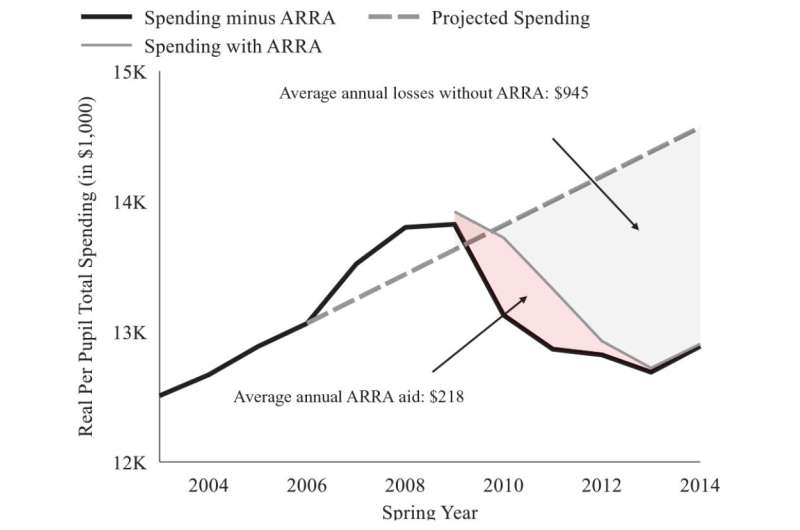Research finds federal pandemic aid to US public schools was insufficient to address student learning loss

Although the federal government provided an unprecedented level of emergency funding to U.S. public schools during the COVID-19 pandemic, this support was insufficient and poorly targeted to offset the cost of recovering student learning loss, according to new research. The study, by Kenneth A. Shores at the University of Delaware and Matthew P. Steinberg at George Mason University, was published today in Educational Researcher.
Shores and Steinberg estimate that $700 billion will be needed to offset COVID-induced learning loss, far more than the $190 billion allocated to public K–12 schools by the federal government through Elementary and Secondary School Emergency Relief (ESSER) funds. ESSER funding was approved through three bills signed into law in 2020 and 2021.
“Despite an extraordinary level of support by the federal government during the pandemic, U.S. schools are still $500 billion short of what’s needed to address unpreceded levels of learning loss,” said Steinberg, associate professor of education and public policy at George Mason University. “While the investment in ESSER was incredible in scale, it pales in comparison to the negative impact on the economy if a generation of children does not recover from what this pandemic has done to them academically.”
To estimate the cost of remediating student learning loss, the authors leveraged prior estimates of learning loss, time spent in remote instruction, and the cost of increasing student achievement, gleaned from existing research studies and data from the U.S. Department of Education, the U.S. Census Bureau, and other sources.
Shores and Steinberg also found that ESSER funds were likely not distributed to places with the greatest learning loss. The emergency aid was allocated to states through the Department of Education’s Title I program, using pre-existing rules that, in part, favor states that spend higher amounts on education. As a result, school districts across the country with similar levels of poverty received very different amounts of support.
In addition, the authors note that while pre-existing Title 1 allocation rules aim to address poverty, COVID-19 learning loss often occurred for reasons not having to with incomes, such as race.
“COVID-19 hit communities of color very hard, regardless of poverty,” said Shores, assistant professor of education policy at the University of Delaware. “Communities of color that may have faced difficult challenges due to the pandemic would not have received the funds needed to remediate student learning losses.”
The authors note that many school districts do not plan to use the majority of ESSER funds they receive to offset learning loss, and that there is little way for policymakers to know how ESSER support is being used.
“Policymakers should require, or least provide incentives to, school districts to use federal aid for remediating student learning losses,” said Steinberg. “This is much more important than using it, for example, for new facilities construction—such as athletic fields—that have little to do with addressing the academic needs of students.”
“School leaders need to take seriously the short- and long-term consequences of learning loss and commit to addressing it with whatever federal resources they have available,” Steinberg said. “At the same time, policymakers should work to establish data monitoring systems to track how districts are spending federal stimulus funds in real time.”
Shores and Steinberg’s study also examined parallels between federal K–12 emergency funding for the COVID-19 pandemic and federal K–12 emergency funding during the Great Recession. They found that funds from the American Recovery and Reinvestment Act (ARRA) were insufficient to fully offset district spending declines for the entire duration of the Great Recession. Lost revenues totaled $223 billion, whereas ARRA aid was only $50 billion and allocated to districts that did not necessarily experience spending declines.
“In both instances, the federal government overly relied on what we think of as ‘distribution channels of convenience’ to allocate the funds,” Shores said. “These distribution channels predate both crises and are poorly aligned with the damage the crises inflicted.”
“Relying on established channels and rules often results in emergency funds not going to the places that need them the most,” said Shores.
Helping students succeed: Addressing pandemic-related learning loss
Kenneth Shores et al, Fiscal Federalism and K–12 Education Funding: Policy Lessons from Two Educational Crises, Educational Researcher (2022). DOI: 10.3102/0013189X221125764
Provided by
American Educational Research Association
Citation:
Research finds federal pandemic aid to US public schools was insufficient to address student learning loss (2022, October 11)
retrieved 11 October 2022
from https://phys.org/news/2022-10-federal-pandemic-aid-schools-insufficient.html
This document is subject to copyright. Apart from any fair dealing for the purpose of private study or research, no
part may be reproduced without the written permission. The content is provided for information purposes only.
For all the latest Science News Click Here
For the latest news and updates, follow us on Google News.

